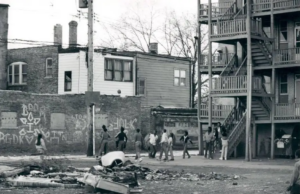The history of Austin is evidence of the complex interplay of social and economic forces combined with the enduring spirit of its residents. From its humble beginnings in the late 19th century to its struggles with disinvestment and urban decay in more recent decades, the story of Austin is one marked by both resilience and adversity.
THE BEGINNING
 In 1893, the seeds of Austin’s development were sown. This pivotal year saw the construction of one of the community’s first schools, laying the foundation for future growth and prosperity. With Austin becoming part of the City of Chicago in 1899, the Robert Emmet School emerged as a cornerstone of the neighborhood.
In 1893, the seeds of Austin’s development were sown. This pivotal year saw the construction of one of the community’s first schools, laying the foundation for future growth and prosperity. With Austin becoming part of the City of Chicago in 1899, the Robert Emmet School emerged as a cornerstone of the neighborhood.
During the early 20th century, Austin witnessed a period of rapid expansion fueled in part by the development of street railways and the allure of its infrastructure to a wave of European immigrants. The community’s population increased greatly, and by 1913, the Robert Emmet School expanded to accommodate the boom. The area was estimated to have over 140,000 residents by the 1920s.
CHANGING DEMOGRAPHICS
A large wave of African Americans moved to Austin toward the end of the Great Migration. The trajectory of the neighborhood took a tumultuous turn. The arrival of African Americans seeking refuge from the Jim Crow South led to a wave of white flight, driven by prejudices and racially motivated practices. This exodus resulted in a dramatic decrease in white residents, businesses, and access to city services, setting the stage for decades of disinvestment and neglect to follow.
The 1960s brought a glimmer of hope to Austin with the extension of the CTA Green and Blue Lines, fostering renewed growth and economic activity in the community. Yet, this progress was overshadowed by the assassination of Dr. Martin Luther King Jr. in 1968, underscoring the broader context of racial tensions and social upheaval gripping the nation.
The 1970s and 1980s saw a pattern of disinvestment in Austin with shrinking city resources and job opportunities as the community’s large employers left. Grassroots initiatives were established to address these challenges. Westside Health Authority (WHA) started in 1988, plus many faith-based and civic organizations were created.
The political landscape further shaped Austin’s ascent, with the mayoral tenures of Jane Byrne and Harold Washington carrying cultural significance as well. While Byrne’s administration favored interests of the white community, Washington’s historic tenure as Chicago’s first Black mayor offered yet another glimmer of hope for marginalized communities.
The 1990s saw a troubling rise in crime, with the Chicago Police Department recording 48 homicides in 1992 alone. As issues like public safety grew, Austin also faced other setbacks like diminishing employment opportunities. Organizations in the social sector helped, but often worked separately, unaware of one another’s assets or goals. An urgent need arose for comprehensive community revitalization efforts and in response, Austin Coming Together was created in 2010 and has been coordinating collective impact efforts ever since.
RISING TO MEET GROWING CHALLENGES
This historical context is the backdrop and inspiration for why there is so much dedication to progress today. Despite the troubles of the past, the commitment and resilience of the community run deep. With more development projects underway than ever before, we are seeing intentional reinvestment in the community. Today, Austin is on a clear path to thriving.


